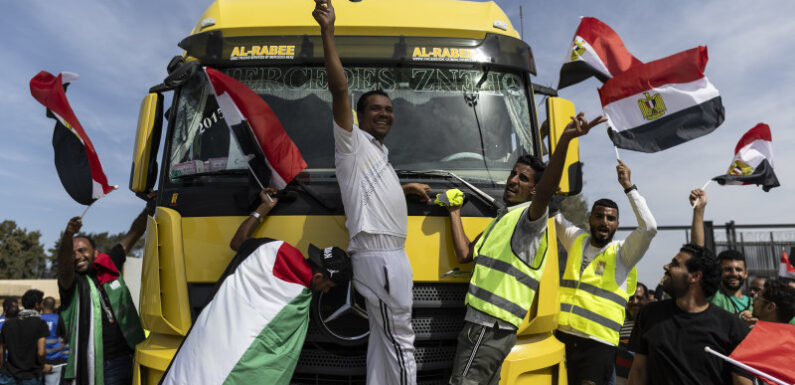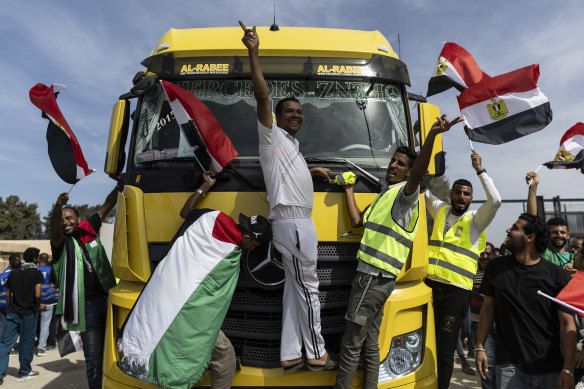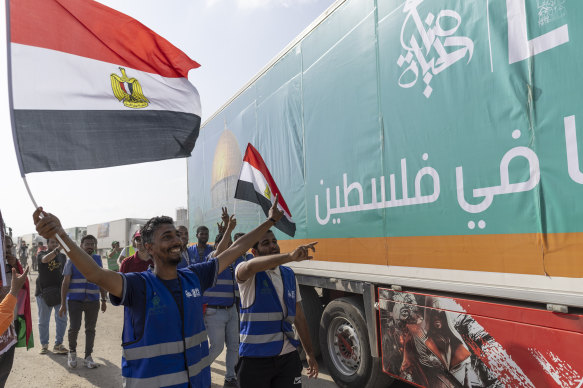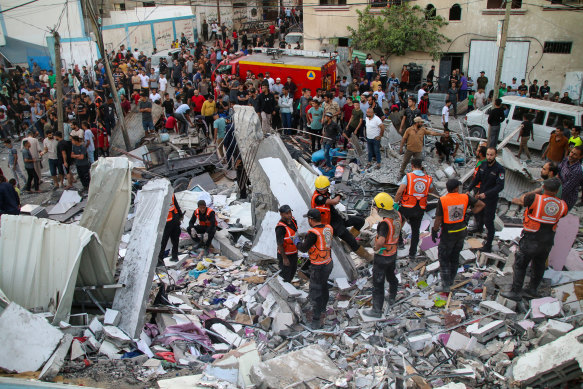
Save articles for later
Add articles to your saved list and come back to them any time.
Israeli warplanes struck targets across Gaza on Monday, including in areas where Palestinian civilians were told to seek refuge, after another aid shipment was allowed into the besieged Hamas-ruled territory.
US President Joe Biden and Israeli Prime Minister Benjamin Netanyahu have agreed that a constant flow of humanitarian aid will be allowed into Gaza, after a second convoy of supplies was allowed in on Sunday.
Volunteers and NGO staff celebrate after unloading aid supplies and returning to the Egyptian side of border near Rafah, in North Sinai, Egypt.Credit: Getty
Seventeen more trucks entered Gaza from Egypt after 20 trucks delivered medical supplies, food and water – but not fuel – the day before.
The convoys marked the end of a 10-day siege of the Gaza Strip, in which Israel denied the entry of any food, water or medicine after Hamas terrorists killed at least 1400 people in Israel. More than 4600 Palestinians have been killed during the Israeli response, according to the Gazan Health Ministry.
Gaza relies on fuel to power its hospitals and water pumps but will run out by Wednesday, the UN warned.
“Without fuel, there will be no water, no functioning hospitals and bakeries. Without fuel, aid will not reach those in desperate need. Without fuel, there will be no humanitarian assistance,” United Nations Relief and Works Agency for Palestine Refugees (UNRWA) Commissioner-General Philippe Lazzarini said
“I call on all parties and those with influence over them to immediately allow fuel supplies into the Gaza Strip and to ensure that fuel is strictly used to prevent a collapse of the humanitarian response.”
The World Health Organisation said seven hospitals in northern Gaza had shut down due to damage from strikes, lack of power and supplies, or Israeli evacuation orders, and that doctors had been forced to perform surgeries with sewing needles, use vinegar as disinfectant and operate without anaesthesia.
Netanyahu has said no supplies would be forthcoming from Israeli territory until Hamas released hostages, of which 212 remain captive after two American women were released late last week, according to new figures relayed by Israeli Defence Forces spokesman Jonathan Conricus on Monday.
The Biden administration has advised Israel to delay its much-anticipated ground invasion of Gaza to allow more time for hostage negotiations and aid deliveries, The New York Times reported.
People wave Egyptian flags as the second convoy of aid trucks crosses from the Egyptian side.Credit: Getty
Officials told the newspaper the US also wanted more time to prepare for potential attacks on nearby American interests by Iranian-backed groups sparked by a ground invasion, but still supported Israel’s intention to move into Gaza.
A diplomat from the Israeli embassy in Washington denied the Times report was true, saying while Israel was in “close dialogue and consultations” with the US, it had not been told to delay an invasion.
Biden reiterated US support for Israel’s right to defend itself in a joint statement with the leaders of Britain, France, Germany, Canada and Italy, which also committed to diplomatic efforts to prevent the conflict from spreading.
In the Israeli-occupied West Bank, two Palestinians were killed at the Jalazone refugee camp near Ramallah, the Palestinian Health Ministry said.
Residents said Israeli forces raided the camp and carried out widespread arrests, as they clashed with gunmen and some youths who threw stones. The Israeli army has not issued a statement about the incident.
Conricus said the Israeli military was stepping up its attacks. It hit Gaza with air strikes early on Monday (Israel time) – a day after striking southern Lebanon, two airports in Syria and a mosque in the occupied West Bank allegedly used by militants.
The Hamas-run Interior Ministry said airstrikes hit residential apartments in the town of Khan Younis and the Nuseirat refugee camp, both of which are south of the Wadi Gaza evacuation line.
Israel repeated its calls for people to leave northern Gaza, including by dropping leaflets from the air. It estimated 700,000 have already fled but hundreds of thousands remain. That would raise the risk of mass civilian casualties in any ground offensive.
Conricus also accused Hezbollah of escalating the conflict. Israeli soldiers and Iranian-backed Hezbollah militants have traded fire across the Israeli-Lebanon border since Hamas’ October 7 incursion into Israel, but the launches so far have targeted limited areas.
“Bottom line is … Hezbollah is playing a very, very dangerous game,” Conricus said. “[It is] extremely important for everybody in Lebanon to ask themselves the question of the price: is the Lebanese state really willing to jeopardise what is left of Lebanese prosperity and Lebanese sovereignty for the sake of terrorists in Gaza?”
Hezbollah has vowed to step up involvement if Israel were to begin a ground invasion of the Gaza Strip. Israel said it would retaliate aggressively and warned Lebanon not to let itself get dragged into a new war.
Netanyahu visited troops stationed near the Lebanese border on Sunday, where he referenced the month-long war with Hezbollah that ended in a tense stalemate in 2006.
Civilians search for victims of an Israeli airstrike in Khan Yunis in Gaza.Credit: Getty Images
“If Hezbollah decides to enter the war, it will miss the Second Lebanon War. It will make the mistake of its life,” Netanyahu said. “We will cripple it with a force it cannot even imagine, and the consequences for it and the Lebanese state are devastating.”
The Egyptian military said Israeli shelling hit a watchtower on Egypt’s side of the border on Monday (AEDT), causing light injuries. The Israeli military apologised, saying a tank had accidentally fired and hit an Egyptian post, and the incident was being investigated.
With AP, Reuters
More coverage of the Hamas-Israel conflict
- Cascading violence: Tremors from the Hamas attacks and Israel’s response have reached far beyond the border. But what would all-out war in the Middle East look like?
- The human cost: Hamas’ massacre in Israel has traumatised – and hardened – survivors. And in Gaza, neighbourhoods have become ghost cities.
- “Hamas metro”: Inside the labyrinthine network of underground tunnels, which the Palestinian militant group has commanded beneath war-ravaged Gaza for 16 years. The covert corridors have long provided essential channels for the movement of weapons and armed combatants.
- What is Hezbollah?: As fears of the conflict expanding beyond Israel and Hamas steadily rise, all eyes are on the militant group and political party that controls southern Lebanon and has been designated internationally as a terrorist group. How did it form and what does Iran have to do with it?
Get a note directly from our foreign correspondents on what’s making headlines around the world. Sign up for the weekly What in the World newsletter here.
Most Viewed in World
From our partners
Source: Read Full Article


